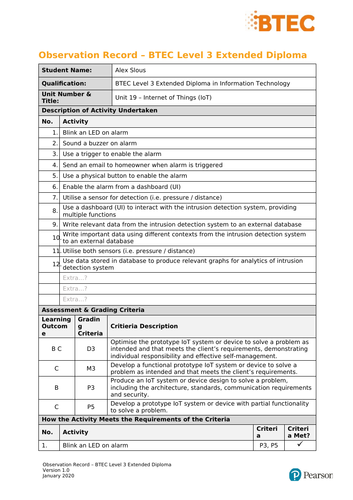

This is the second of two assignments that make up the Internet of Things (IoT) unit. The biggest challenge of the unit is this assignment by far since it requires a lot of practical work and stressful deadlines. There are three stages to this assignment, and therefore three files. Stage one is designing your IoT device, although the type of device should be assigned to you to alleviate some of the pressure and you can always refer to tutors and fellow students for advice.
Prototyping is the second stage and it consists of building and programming your prototype, although from my experience the programming is the easiest part. The Raspberry Pi code is included in the .json below file and was developed using Node-Red. Design specifications are also included in the initial design document.
The final stage is having your device tested by a tutor against a set of criteria that should have been made clear at the beginning of the process. However, criteria will vary depending on the tutor and device type. That criteria is included in both the design document and the testing documentation. This documentation was awarded a distinction grade.
JSON FILE:
https://drive.google.com/file/d/1FIEhhfrfUKlWsbE0AEcwG7OhDACgl36k/view?usp=sharing
Get this resource as part of a bundle and save up to 38%
A bundle is a package of resources grouped together to teach a particular topic, or a series of lessons, in one place.
Full Collection (10 Assignments + Extras)
This is all of my currently available work.
The Internet of Things (IoT) Bundle (Assignments 1-2)
These are the two assignments that make up the Internet of Things (IoT) unit. The first assignment compares and evaluates how multiple different IoT devices are used to improve the quality of life and collect data. The devices used were Smart Speakers, Abilify MyCite. Smart TVs, Electronic Shelf Labels (ESLs) and Roombas. The biggest challenge of the unit is the second assignment by far since it requires a lot of practical work and stressful deadlines. There are three stages to this assignment, and therefore three files. Stage one is designing your IoT device, although the type of device should be assigned to you to alleviate some of the pressure and you can always refer to tutors and fellow students for advice. Prototyping is the second stage and it consists of building and programming your prototype, although from my experience the programming is the easiest part. The Raspberry Pi code is included in the .json below file and was developed using Node-Red. Design specifications are also included in the initial design document. The final stage is having your device tested by a tutor against a set of criteria that should have been made clear at the beginning of the process. However, criteria will vary depending on the tutor and device type. That criteria is included in both the design document and the testing documentation. These were awarded a distinction grade. JSON FILE: https://drive.google.com/file/d/1FIEhhfrfUKlWsbE0AEcwG7OhDACgl36k/view?usp=sharing Image Credit: Computer World https://www.computerworld.com/article/3444199/iot-dangers-demand-a-dedicated-group.html
Something went wrong, please try again later.
This resource hasn't been reviewed yet
To ensure quality for our reviews, only customers who have purchased this resource can review it
Report this resourceto let us know if it violates our terms and conditions.
Our customer service team will review your report and will be in touch.
